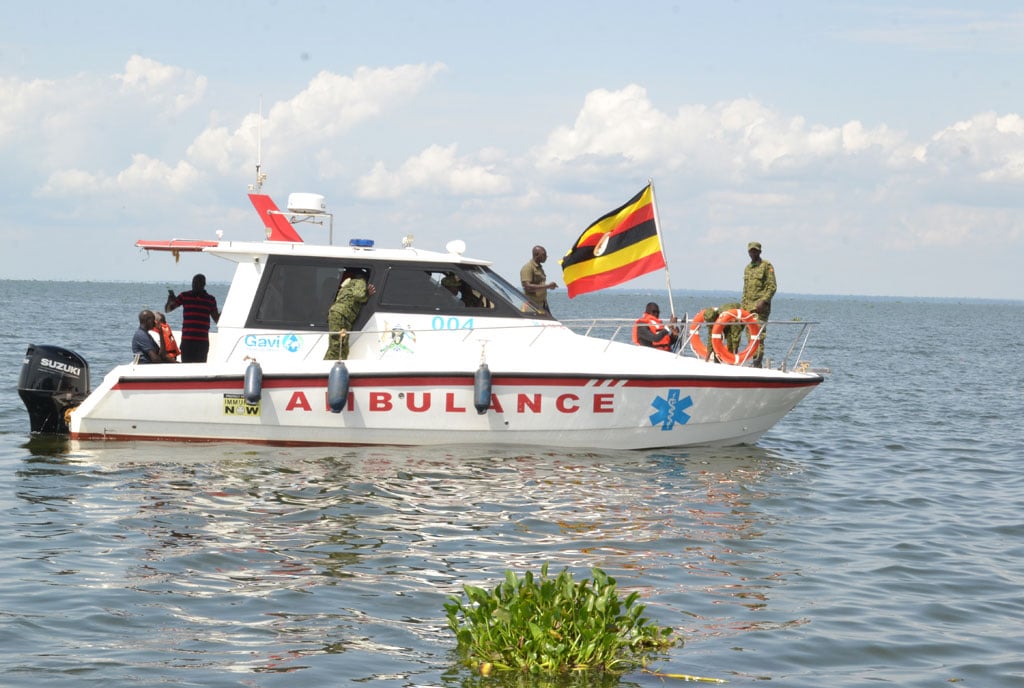Ministry seeks 4 boat ambulances

A UPDF marines boat docks at a pier after returning from the accident scene. Photo | Ivan Walunyolo
What you need to know:
Besides victims of drowning, boat ambulances transport pregnant mothers and other patients on several islands of Lake Victoria.
The Ministry of Health has said it needs four boat ambulances, each costing around $180,000 (Shs666 million) to reduce deaths from water accidents on Lake Victoria.
Dr John Baptist Waniaye, the commissioner of Emergency Medical Services (EMS) at the ministry, told the Daily Monitor yesterday that having boat ambulances is part of the robust strategy coordinated by the Office of the Prime Minister to prevent drowning.
ALSO READ: Obongi to get boat ambulance
“We have so far acquired 14 of the boat ambulances but we require 25 on the major water bodies [in the country]. For Lake Victoria, we have seven boat ambulances but we need an additional four,” Dr Waniaye said.
Besides victims of drowning, boat ambulances are used to transport pregnant mothers and other critically ill patients on several islands of Lake Victoria who need emergency medical services.
“These (boat ambulances) help in terms of rescue so that drowning victims easily access these boats and they are moved to the lakeshore while they are receiving care. Each boat ambulance costs around $180,000 (Shs666 million) to $190,000 (Shs700 million),” Dr Waniaye said.
While on the boat ambulance, Dr Waniaye explained, the paramedics provide the drowning victim basic life-saving care (first aid) to clear the airways so the person can breathe.
Dr Waniaye was commenting on the tragic incident on Lake Victoria on Wednesday where 25 people reportedly lost their lives when their boat capsized. Still, five had been rescued by Wednesday evening.
The large boat, fishermen said on Wednesday, was carrying 34 bags of charcoal, fresh foods and silverfish from a landing site in Kalangala District. Police have blamed the incident on “overloading and bad weather”.
At least 3,500 Ugandans across 74 districts have drowned over a two and half-year period, according to a 2021 report by Makerere University School of Public Health. This translates into 1,400 cases per year.
Dr Frederick Oporia, a water transport safety expert at the School of Public Health, said available data shows that in lakeside fishing communities, “Uganda has the world’s highest drowning death rate of 502 per 100,000 cases. That is 60 times higher than the estimate on the continent.”
The Commissioner of EMS on the other hand said they are working with the Ministry of Works and Transport to put up rescue centres with rescue clinics on central water bodies where they shall place paramedics to provide better medical care. “There are sites that have been chosen on Lake Victoria where the rescue centres are being constructed,” Dr Waniaye added.
According to a June 2023 update from the East African Community’s Lake Victoria Basin Commission, the government of Uganda through the Ministry of Works and Transport of Uganda, received financing from the African Development Bank for the construction of the Maritime Rescue Coordination Centre at Entebbe.
Information from the Ministry of Works indicates that works are ongoing to improve safety within Ugandan Waterways through enhancing the “Search and Rescue system and establishing reliable weather monitoring systems on major Ugandan lakes including Lakes Victoria, Kyoga and Albert”.
“To enhance Search and Rescue capabilities, the Ministry of Works and Transport has acquired a Mobile Search and Rescue (SAR) Facility called DELTA 1 and a well-equipped ambulance boat, which will soon be launched and will be able to respond to any major distress incident to save lives,” information from the ministry reads.
Dr Waniaye also said they are working with other sectors and partners to do sensitisation on ways to prevent water accidents and drowning such as wearing life-jackets and swimming.
“We are also participating in sensitisation because the concept of drowning involves some of the preventable situations like someone going to swim or to fish while drunk. But if someone has a chronic condition which can impair their functionality –like epilepsy, diabetes, these people are sensitised to make them understand their vulnerability,” he added.




